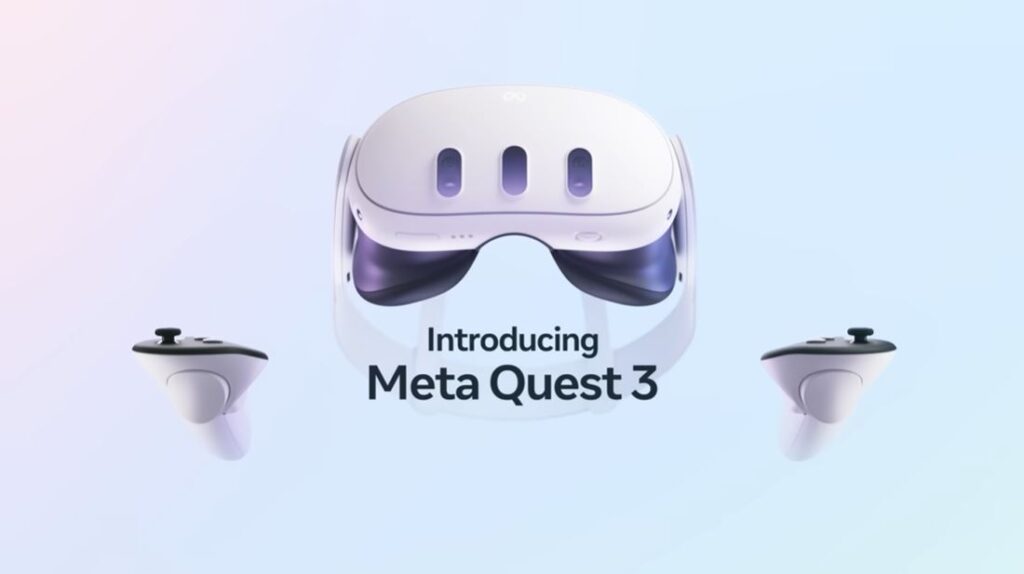Table of Contents
- Leaked Quest 3 Setup Videos Showcase ‘Smart Guardian’ Room-Scanning Feature
- A Sneak Peek at Quest 3’s New User Experience: Samulia’s Uncovered Videos
- Meta’s Vision: Blending Physical and Virtual Worlds with Quest 3
- Samulia’s Track Record: Uncovering Quest Features Before Official Announcements
- Quest 3’s Official Announcement and Enhanced Specifications
- Examining Quest 3’s Room Scanning in Leaked Animation Clips
- Comparing XR Elite and Quest 3: Advancements in Room Scanning
- The Benefits of 3D Room Mesh for Virtual and Mixed Reality
- Improved Guardian System
- Recap of What We’ve Learned from The Leak
- Pro Tips for Utilizing Quest 3’s Room Scanning Abilities
- Questions and Answers on Room Scanning in Quest 3
Meta, the company most known for developing the wildly successful Oculus Quest VR headsets, has announced a new standalone VR headset called Quest 3. This highly anticipated release improves upon the Quest 2 in many ways, including the introduction of the innovative “Smart Guardian” safety feature.
It appears that the long-standing claims about Quest 3’s extraordinary room-scanning capabilities have been confirmed by the appearance of leaked setup videos online, sparking intense speculation among tech aficionados. Meta’s Quest 3 looks set to revolutionize the virtual reality experience by introducing new standards of user protection, interactivity, and realism. Let’s get into it!
Leaked Quest 3 Setup Videos Showcase ‘Smart Guardian’ Room-Scanning Feature
A series of videos showcasing what looks to be an early version of the Quest 3 user experience have been unearthed by the renowned data miner ‘Samulia’. These movies show how the guardian feature of the headset may be activated and used to avoid damaging your real-world surroundings while you’re immersed in a virtual one.
A Sneak Peek at Quest 3’s New User Experience: Samulia’s Uncovered Videos
The movies, which appear to be prototypes, are similar to the tutorials that Meta normally includes to help users get started with their headsets. The videos, shared by Twitter user @Lunayian, show a user scanning their play area with the Quest 3’s internal sensors. Sofas, coffee tables, workstations, TVs, desktop PCs, and ornamental items are just some of the things that the sensors can identify and blend together.
In subsequent films, the Smart Guardian function is seen in action, warning the user of potential danger. A major workspace marking feature, like that of Quest 2 and Quest Pro, is also included. The movies provide a quick glimpse into a mixed-reality experience in which the user can interact with a virtual ball that can use the user’s own furniture as a playing field. Simply put, this shows the capabilities of bouncing a virtual ball off real world objects.
Via Samulia, some early NUX animations for Meta Quest 3's room scanning technology.
🧵 (1/4) pic.twitter.com/7AaerFv9QE
— Luna (@Lunayian) June 11, 2023
Meta’s Vision: Blending Physical and Virtual Worlds with Quest 3
Meta has yet to reveal specifics regarding the Smart Guardian technology but has promised that the real and virtual worlds would merge in Quest 3. According to the business, the system can detect and react to tangible things in the user’s environment, making for a more seamless and natural experience.
Samulia’s Track Record: Uncovering Quest Features Before Official Announcements
Samulia has a history of discovering new features via mining data from Quest firmware versions before they are officially announced. In 2021, they uncovered a new user experience film that showed off the Quest Pro for the first time. Samulia also uncovered the Meta logo months before the firm revealed it during its pivot announcement in February 2022.
Leaked films of automatic room scanning were found in version 55 of the Quest firmware available through the Public Test Channel. Users can expect to see these videos while setting up their Quest 3 headsets.
Quest 3’s Official Announcement and Enhanced Specifications

Photo from Meta Quest YouTube
Even though the Quest 3 was officially unveiled by Meta recently, we still don’t know all the details. In contrast to the Quest Pro, the business claims their new product has a 40% thinner visor, a GPU that is twice as powerful, and a better color passthrough. Dual 4-megapixel cameras and a depth sensor enable these enhancements.
Examining Quest 3’s Room Scanning in Leaked Animation Clips
One of the stolen videos features a user looking at their room’s decor. The depth sensor, which is presumably represented by a beam emanating from the headset, creates a blue mesh around the items. After all of the items have been meshed, the film skips ahead to the final stage of the room scan, where a “Finish Scan” interface is shown.
Comparing XR Elite and Quest 3: Advancements in Room Scanning
Additionally, a depth sensor and a beta version of auto-room-settings are included in HTC’s Vive XR Elite. However, XR Elite can only scan flat objects like walls and ceilings, so you won’t be able to use it to scan your entire space. In contrast, the snuck-out video from Quest 3 shows off accurate meshing of intricate 3D models. Whether or whether the clip’s degree of detail is representative of Quest 3’s actual capabilities remains unclear.
The Benefits of 3D Room Mesh for Virtual and Mixed Reality
Virtual and mixed reality applications can benefit from the capability to produce a 3D room model. Existing Quest headsets allow users to see through to the floor, allowing them to manually establish Guardian borders. When a user gets within eight feet of one of these borders, a virtual wall appears. However, even if the user is tall enough to reach over the furniture, this strategy limits VR use to areas with no obstructions.
Improved Guardian System
The feature “Smart Guardian” for Quest 3 was referenced in a leaked Meta product roadmap that was published by The Verge in March. The user in virtual reality may apparently see the contour of neighboring furniture and receives a warning when approaching real walls, as shown in one of the leaked movies. This improved Guardian system would open up more of the user’s room to be used for interactive activities, such as the area above the bed and the table.
The room mesh is what allows virtual and physical items to interact in mixed reality. Furniture, tables, and walls can all play a role in hiding or revealing virtual things. These kinds of mixed-reality interactions are demonstrated in one of the stolen videos.
Using room-aware mixed reality with current Quest headsets calls for the manual labeling of rectangular cuboids to represent walls and furniture. As a result of the effort required to utilize scene graph capabilities, Quest has made very little use of them. A depth sensor was planned for inclusion in Quest Pro but was cut in the final weeks before the game’s release. Quest Pro could have used the same room scanning features as Quest 3 if they were included.
Recap of What We’ve Learned from The Leak
The leaked cartoons show how Quest 3 will scan customers’ rooms with its depth sensor. According to 2022 leaks posted by SadlyitsBradley, neither the base model nor the more priced Quest Pro has a depth sensor. At the unveiling of the device, Meta confirmed the report and touted the depth sensor as a game-changing addition to “Meta Reality.”
An improved augmented reality experience is on the way with Quest 3, thanks to the addition of a depth sensor. The depth sensor allows for automatic room mapping in addition to enhanced hand tracking. Like Apple’s Vision Pro, this means the sensor will be able to identify and map the layout of a whole space, allowing for more accurate positioning of walls, furniture, and other objects.
Early films showing the room scan technology in action have been leaked and shared on Twitter. These videos are of poor quality because they were shot at an early point in the production process and are all that exist.
With Quest 3’s depth sensor, customers no longer have to manually create the guardian system, which is a huge gain. In order to designate a safe playing area, users of the present guardian system must first create virtual borders. However, as can be seen in the hacked films, this will now be done automatically thanks to the depth sensor.
In addition, in Quest 3, digital goods will be capable of interacting with the physical environment. The potential for realistic virtual interactions is demonstrated in the leaked clip by the virtual ball’s ability to bounce off of walls and furniture when thrown into the user’s room.
Pro Tips for Utilizing Quest 3’s Room Scanning Abilities
According to the hacked footage, Quest 3’s room scanning features would make VR more immersive. Some expert advice on how to get the most out of this function:

Photo from Meta Quest YouTube
Take some time to get the layout of your play area just right before you start scanning the room. Make sure there aren’t any distractions in the vicinity that could ruin your virtual reality experience. Take out anything you don’t want banging into something else, especially if it’s fragile or expensive.
It’s important to think about the lighting because it affects the accuracy of your room scans. The depth sensor’s ability to accurately capture objects and surfaces depends on how well-lit the room is. It’s best to avoid scanning in low-light or overly bright areas, as this could compromise the image quality.
Scanning while moving around as demonstrated in the leaked films, so try different spots. Try different positions for the Quest 3 headset while you’re scanning. Change the vantage point for better item coverage and smoother meshing.
Once the scan of the room is complete, you may put Quest 3’s object recognition features to the test. Examine the results of the virtual objects’ interactions with the room’s physical features by moving around the space. To further enhance the mixed reality experience, users can throw virtual objects and observe how they interact with real-world surfaces.
It is anticipated that the manual process of setting up guardian limits will be unnecessary after using the room scanning feature in Quest 3. However, it’s a good idea to double-check and tweak the limits to your liking before using them. Because of this, you won’t bump into anything by accident and will always know where you are in the room.
Participate in Group Activities Thanks to Quest 3’s room scanning features, you and your loved ones may take part in exciting group activities. Using the resulting 3D room model, you can design collaborative VR settings where several users may move around and interact with each other and real-world objects. By incorporating real-world components, collaborative games, and experiences will reach new heights.
While the hacked movies offer intriguing glimpses into Quest 3’s possibilities, it is crucial to keep up with official statements from Meta. The final product could have improved room scanning through the addition of new features, tweaks, or adjustments. If you stay on top of official updates, you’ll always be up-to-date and ready to get the most out of your headset.
Keep in mind that the hacked videos are based on prototypes, therefore the room scanning feature in Quest 3 may seem different in the final game. If you want to get the most out of Meta, you should check out the official lessons and guidelines they produce.
The ability to scan rooms in Quest 3 may help to dissolve the boundary between the digital and real worlds. Users can construct fully immersive experiences that incorporate their physical environments into their virtual journeys with some planning and experimentation.
While this information is certainly interesting, customers will have to wait for formal confirmation and additional details from Meta in order to properly appreciate the room-scanning capabilities of the future Quest 3 headset. However, if the movies that have been leaking online are anything to go by, Quest 3 might completely transform the virtual reality industry.
Questions and Answers on Room Scanning in Quest 3
What is Quest 3 room scanning?
The Quest 3 headset’s room scanning feature uses the depth sensor and inside-out tracking to identify and create a map of the user’s immediate surroundings. By allowing users to interact with physical items and surfaces in VR, it creates a more lifelike experience.
What is the procedure for scanning a room in Quest 3?
The leaked videos show the Quest 3 headset’s depth sensor emitting a beam that scans the area, but the full details of the room scanning process have not been formally published. Objects’ positions and shapes are detected by the sensor and rendered as a mesh in the computer simulation.
When playing Quest 3, what are the advantages of scanning rooms?
Room scanning improves the virtual reality experience by letting digital content interact with the physical world. Better collision detection, occlusion of virtual items by actual ones, and the incorporation of real-world surfaces into the virtual world are all made possible by this technology. This enhancement can help VR games and experiences feel more realistic and lifelike.
When scanning a room in Quest 3, can I do it in any space?
While Quest 3’s room scanning function is designed to function in a variety of settings, it may be affected by factors like illumination and the complexity of the room’s layout. It’s more likely that you’ll get accurate readings in well-lit areas with distinct boundaries and objects. Scanning accuracy may be reduced in overly bright or crowded environments.
Will room scanning in Quest 3 eliminate the need for guardian boundaries?
According to the leaked footage, room scanning in Quest 3 may make the current method of manually establishing guardian limits unnecessary. You should modify the perimeters to fit your needs for privacy and security. Meta’s official announcements will shed light on how the guardian system will be implemented in its ultimate form for Quest 3.
Is room scanning on Quest 3 compatible with augmented and virtual reality applications?
Yes, Quest 3’s room scanning features can be used to create mixed-reality adventures. The mesh that is created from the room scan enables realistic interactions between virtual items and physical surfaces, such as occlusion and precise physics. This capability paves the way for more interesting and compelling mixed-reality software.
When will Quest 3’s room scanning feature get official instructions and tutorials?
It is believed that Meta will provide official lessons and instructions to help users get the most out of Quest 3’s room scanning, but for now, leaked films provide early insights into this function. Room scanning can be used more efficiently with the help of these materials, which provide detailed instructions, helpful hints, and recommended procedures.
Where can I get Quest 3 and when will it be released?
At this time, we don’t know when exactly Quest 3 will be released. Keep an eye out for formal announcements from Meta on when and how you can get your hands on the headset. Once Quest 3 is released, it will be available on Meta’s official website and at approved shops.
These frequently asked questions have been compiled based on speculation and leaked footage; official details from Meta may change.
If you want to learn more about the Meta Quest 3, check this out.






